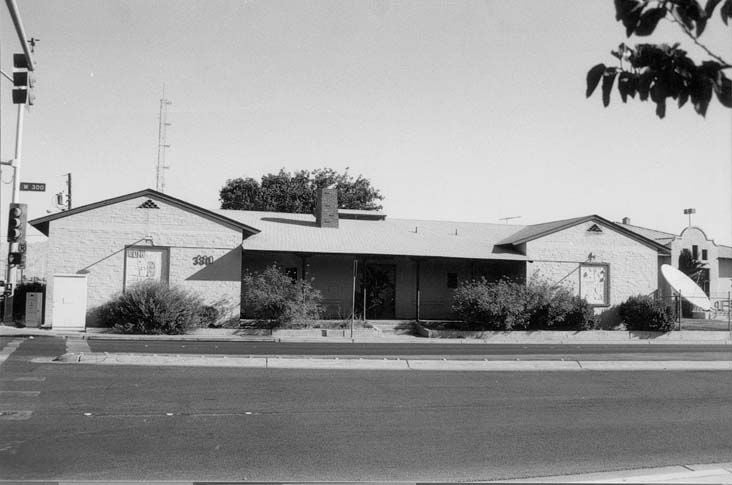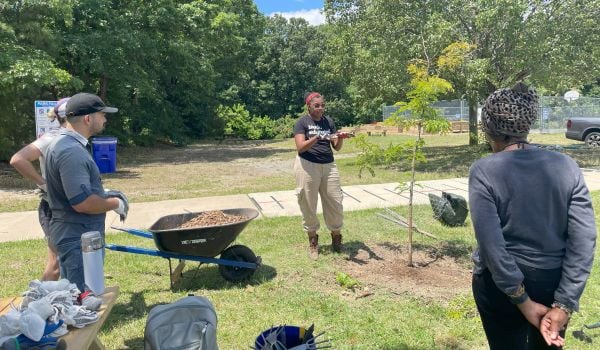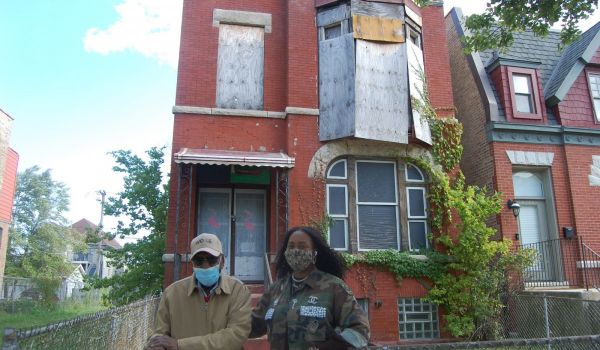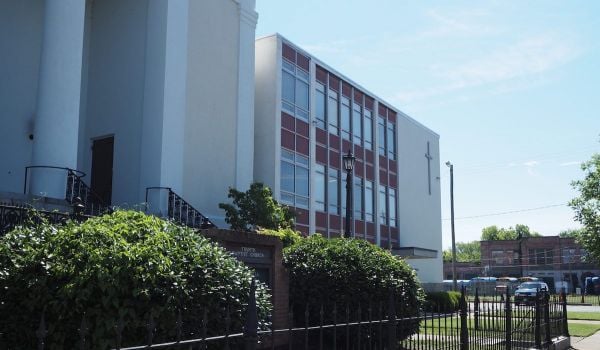Westside School, which opened in 1921, was the first grammar school in west Las Vegas. It was the first public school attended by Native American students from the Paiute Indian reservation, about a mile away. During World War II, black families migrated out of the rural South and moved into the neighborhood around the school, seeking factory jobs. The school became an anchor for the city’s black community, and it eventually was the first school in the city to be racially integrated.
But by the time the building got entered into the National Register of Historic Places in 1979, it was unoccupied and boarded up. “Though time and indifference have taken their toll, the building retains an appearance of quiet dignity,” read the registry nomination forms for the school.
The city-owned property started a new chapter last year, when it re-opened after rehabilitation as a community center and office space. A local radio station, which rented space in the building before the rehab, moved to a different part of the complex. Tech Impact, a nonprofit with an IT job training program, has already moved in, and Deputy City Manager Scott Adams says there is around 6,000 to 8,000 square feet still available for rent.
The $12.5 million rehab, which preserved the historic character of the building, got $4 million via the federal New Markets Tax Credit program. It was one of the first projects that got NMTC financing through the Las Vegas Community Investment Corporation, a city-controlled nonprofit created in 2013.
“There really hasn’t been engagement in the past with New Markets Tax Credits in the state of Nevada,” says Adams.
NMTCs attract private investment to economically distressed areas for the purpose of economic development. But instead of the federal government handing out the credits to investors, organizations compete for allocations of tax credits, and then “sell” them to private investors — usually banks. These organizations, known in federal lingo as community development entities, or CDEs, are mostly affiliated with banks, nonprofit community development corporations or community development financial institutions.
But it’s not unusual for cities or states to create or register existing public and semi-public entities as CDEs. Philly’s PIDC, Invest Atlanta, Chicago Development Fund, Los Angeles Development Fund, NYC Economic Development Authority, Empire State Development and California Statewide Communities Development Authority are all examples of city- or state- affiliated CDEs.
While there are other CDEs that list Nevada as part of multi-state or national target investment areas, the Las Vegas Community Investment Corporation is the only CDE located in Nevada. It got a New Markets Tax Credit allocation for $28 million in 2014, and part of that went to the Westside School renovation; it just got another $55 million allocation in the combined 2015/2016 round of New Markets Tax Credit allocations from the U.S. Treasury.
Public or semi-public CDEs hark back to an earlier era of community development, dominated by Community Development Block Grants or the HOME program. These grant programs flow mainly through city, county and state governments. As these programs continue to have their funding cut year after year, New Markets Tax Credits are helping to fill in some of the gaps, letting state and local governments get back some of their lost ability to finance community development.
“If you look at the federal funding side of community development, since 1980 or so, the share of these programs as a percentage of GDP has been cut by 75 percent, between HUD, CDBG [Community Development Block Grants], the HOME program, the Department of Commerce and other sources,” says Bob Rapoza, spokesperson for the NMTC Coalition, which advocates for New Markets Tax Credits in Washington, D.C. “There is really a shortage of capital of funding for the kinds of projects that people want to do. That’s why this tax credit has become so valuable to communities.”
Clark County, which contains Las Vegas, purchased the Westside School property in 1975 for $25,000 using Community Development Block Grant funding. The city took ownership of the property later, but it had never really been fully reactivated.
“It kind of limped along,” says Adams. “It’s one of those older buildings that has had a number of different uses. Different nonprofits have rented space through the years. Most of it has been vacant all this time.”
Preserving the historical character of the 2-acre property has been a priority since the time the county sought its designation as a historic site. The area remains a hub for black communities in Las Vegas, with a large number of churches in the neighborhood, although many residents have moved away from the blight and lack of opportunity. The mostly vacant former school didn’t help with that. With the school rehabbed as an anchor, and some space still to rent out, Adams says the city is working closely with civic and religious leaders in the neighborhood to use the property as a catalyst for broader revitalization. Phase two of the project may see more New Markets Tax Credits to add further retail and office space.
“As a city, we look at anchor projects like this as catalysts or a stimulator,” says Adams. “There’s been a lot of revitalization efforts in west Las Vegas over the past several decades, but always outside-in. This time the intent has been doing it inside-out.”
With the news of its New Markets Tax Credits locally, the city has received a significant response from communities interested in taking advantage of the program. The school was one of around five projects listed on the city’s initial application to register its CDE with the U.S. Treasury. They’ve since gotten up to around 80 or 90 potential New Markets Tax Credit projects at various stages in the pipeline.
“And they’ve come from all over the place — our advisory council, council members, some come directly from community after hearing about it in the media,” says Adams.
The city formed an advisory council of around seven residents and other representative voices from economically distressed areas of the city to help source and evaluate potential projects for New Markets Tax Credits. The U.S. Treasury requires CDEs to maintain accountability to target communities, and advisory councils are one approach to meeting that mandate. Adams says they meet with them at least once a month, and even more frequently in the periods right after receiving an allocation.
A board of directors, consisting of seven city staff from various agencies relevant to economic development, makes final decisions on New Markets Tax Credit projects. City council, while they are kept in the loop on potential projects and can weigh in with advice or opposition, is not supposed to be the final decision-maker for New Markets Tax Credits, according to program rules from the U.S. Treasury.
Adams estimates about a half dozen city staff work on NMTC deals, from sourcing and vetting to implementation to monitoring. Each project has seven years from the time it receives investment to reach targeted job creation or other economic development goals prescribed by the U.S. Treasury.
“Once you get in it’s like a little machine. You’ve got to keep it going,” Adams says.
The Equity Factor is made possible with the support of the Surdna Foundation.

Oscar is Next City's senior economic justice correspondent. He previously served as Next City’s editor from 2018-2019, and was a Next City Equitable Cities Fellow from 2015-2016. Since 2011, Oscar has covered community development finance, community banking, impact investing, economic development, housing and more for media outlets such as Shelterforce, B Magazine, Impact Alpha and Fast Company.
Follow Oscar .(JavaScript must be enabled to view this email address)












